
Many Muslims believe that prophet Muhammad or someone special can help them on the Day of Judgment. However, the Quran makes it clear that no one, including Prophet Muhammad, can intercede and help anyone on that day. This is proven in verses 82:17-19.
| وَمَا أَدْرَاكَ مَا يَوْمُ الدِّينِ ثُمَّ مَا أَدْرَاكَ مَا يَوْمُ الدِّينِ يَوْمَ لَا تَمْلِكُ نَفْسٌ لِّنَفْسٍ شَيْئًا ۖ وَالْأَمْرُ يَوْمَئِذٍ لِّلَّهِ |
| And what can make you know what is the Day of Recompense? Again, what can make you know what is the Day of Recompense? It is the Day when a soul will not possess for another soul [power to do] a thing; and the command, that Day, is [entirely] with Allah. (82:17-19) |
According to verse 46:9, prophet Muhammad doesn’t know what will happen to himself let alone anyone else. His job was just to warn people.
| قُلْ مَا كُنتُ بِدْعًا مِّنَ الرُّسُلِ وَمَا أَدْرِي مَا يُفْعَلُ بِي وَلَا بِكُمْ ۖ إِنْ أَتَّبِعُ إِلَّا مَا يُوحَىٰ إِلَيَّ وَمَا أَنَا إِلَّا نَذِيرٌ مُّبِينٌ |
| Say, “I am not something original among the messengers, nor do I know what will be done with me or with you. I only follow that which is revealed to me, and I am not but a clear warner.” (46:9) |
According to verses 7:188 and 10:49, prophet Muhammad had no power of good or harm to himself and he had no knowledge of the unseen.
| قُل لَّا أَمْلِكُ لِنَفْسِي نَفْعًا وَلَا ضَرًّا إِلَّا مَا شَاءَ اللَّهُ ۚ وَلَوْ كُنتُ أَعْلَمُ الْغَيْبَ لَاسْتَكْثَرْتُ مِنَ الْخَيْرِ وَمَا مَسَّنِيَ السُّوءُ ۚ إِنْ أَنَا إِلَّا نَذِيرٌ وَبَشِيرٌ لِّقَوْمٍ يُؤْمِنُونَ |
| Say (O Muhammad), “I hold not for myself [the power of] benefit or harm, except what Allah has willed. And if I knew the unseen, I could have acquired much wealth, and no harm would have touched me. I am not except a warner and a bringer of good tidings to a people who believe.” (7:188) |
| قُل لَّا أَمْلِكُ لِنَفْسِي ضَرًّا وَلَا نَفْعًا إِلَّا مَا شَاءَ اللَّهُ ۗ لِكُلِّ أُمَّةٍ أَجَلٌ ۚ إِذَا جَاءَ أَجَلُهُمْ فَلَا يَسْتَأْخِرُونَ سَاعَةً ۖ وَلَا يَسْتَقْدِمُونَ |
| Say (O Muhammad), “I possess not for myself any harm or benefit except what Allah should will. For every nation is a [specified] term. When their time has come, then they will not remain behind an hour, nor will they precede [it].” (10:49) |
According to verse 39:19, God makes it clear that no one can save anyone else who is in Hell.
| أَفَمَنْ حَقَّ عَلَيْهِ كَلِمَةُ الْعَذَابِ أَفَأَنتَ تُنقِذُ مَن فِي النَّارِ |
| Then, is one who has deserved the decree of punishment [to be guided]? Then, can you save one who is in the Fire? (39:19) |
According to verses 2:48 and 2:123, no intercession will be accepted to help anyone on the Day of Judgement.
| وَاتَّقُوا يَوْمًا لَّا تَجْزِي نَفْسٌ عَن نَّفْسٍ شَيْئًا وَلَا يُقْبَلُ مِنْهَا شَفَاعَةٌ وَلَا يُؤْخَذُ مِنْهَا عَدْلٌ وَلَا هُمْ يُنصَرُونَ |
| And fear a Day when no soul will suffice for another soul at all, nor will intercession be accepted from it, nor will compensation be taken from it, nor will they be aided. (2:48) |
| وَاتَّقُوا يَوْمًا لَّا تَجْزِي نَفْسٌ عَن نَّفْسٍ شَيْئًا وَلَا يُقْبَلُ مِنْهَا عَدْلٌ وَلَا تَنفَعُهَا شَفَاعَةٌ وَلَا هُمْ يُنصَرُونَ |
| And fear a Day when no soul will suffice for another soul at all, and no compensation will be accepted from it, nor will any intercession benefit it, nor will they be aided. (2:123) |
The fact that no intercession will exist is reiterated in 2:254.
| يَا أَيُّهَا الَّذِينَ آمَنُوا أَنفِقُوا مِمَّا رَزَقْنَاكُم مِّن قَبْلِ أَن يَأْتِيَ يَوْمٌ لَّا بَيْعٌ فِيهِ وَلَا خُلَّةٌ وَلَا شَفَاعَةٌ ۗ وَالْكَافِرُونَ هُمُ الظَّالِمُونَ |
| O you who have believed, spend from that which We have provided for you before there comes a Day in which there is no exchange and no friendship and no intercession. And the disbelievers – they are the wrongdoers. (2:254) |
According to verse 9:80, even if prophet Muhammad asks 70 times for God to forgive someone, God will not forgive.
| اسْتَغْفِرْ لَهُمْ أَوْ لَا تَسْتَغْفِرْ لَهُمْ إِن تَسْتَغْفِرْ لَهُمْ سَبْعِينَ مَرَّةً فَلَن يَغْفِرَ اللَّهُ لَهُمْ ۚ ذَٰلِكَ بِأَنَّهُمْ كَفَرُوا بِاللَّهِ وَرَسُولِهِ ۗ وَاللَّهُ لَا يَهْدِي الْقَوْمَ الْفَاسِقِينَ |
| Ask forgiveness for them, [O Muhammad], or do not ask forgiveness for them. If you should ask forgiveness for them seventy times – never will Allah forgive them. That is because they disbelieved in Allah and His Messenger, and Allah does not guide the defiantly disobedient people. |
According to verse 9:113, prophet Muhammad and believers are forbidden from praying for polytheists, even if they were close relatives.
| مَا كَانَ لِلنَّبِيِّ وَالَّذِينَ آمَنُوا أَن يَسْتَغْفِرُوا لِلْمُشْرِكِينَ وَلَوْ كَانُوا أُولِي قُرْبَىٰ مِن بَعْدِ مَا تَبَيَّنَ لَهُمْ أَنَّهُمْ أَصْحَابُ الْجَحِيمِ |
| It is not for the Prophet and those who have believed to ask forgiveness for the polytheists, even if they were relatives, after it has become clear to them that they are companions of Hellfire. (9:113) |
Related articles
- Proof Muslim Women Don’t Have to Cover Their Hair
- Proof the Hadith is Not Valid Islamic Law
- Muslims Are Performing the Hajj Wrong
- Muslims Are Wrong About Zakat
- Lailat Al-Qadr Is Not What You Think It Is
- Most Muslims Start & End Fasting At the Wrong Time
- Islamic Misconceptions About the Call to Prayer (Adhaan)
- Most Muslims Are Wrong About Various Aspects of Prayer
- Islamic Ablution (Wudhu) Is Simpler Than Many Muslims Think
- Muslims Don’t Need to Perform Ablution (Wudhu) Before Touching the Quran
- Deferring Matters of Islamic Law to Religious Scholars Is Not Permissible. Studying and Understanding the Quran is Required.
- Proof That the Quran Is Complete and That the Hadith Books Are Not Needed
- Prayer Among Jews, Christians, and Muslims – A Quranic Analysis
- The Testimony (Shahadah) to Convert to Islam is Inaccurate
- Categories of People According to the Quran
- Jews and Christians Are Actually Muslims
- Abraham, Not Muhammad, Was the Founder of Islam
- Jewish, Christian and Islamic Scriptures
- The Fallacy That Descendants of Prophet Muhammad Are Superior to Everyone Else
- Islamic Prophets, Messengers & Scriptures
- What is God’s Name – A Quranic Analysis
- Aliens Do Exist – A Quranic Analysis
- Most Muslims Are Asian, Not Arab
- Proof That Relatives (Wives, Children, Descendants, etc) of Islamic Prophets, Including Muhammad, Are Not Automatically Righteous
- There Is No Punishment for Blasphemy in Islam
- Proof That Arabic is Not a Holy or Superior Language
- Proof That Prophet Muhammad Is Not Exclusive or Superior to Other Prophets
- Muslims (Submitters) and Mu’mins (Believers) Are Not the Same Thing
- Most Jews, Christians, and Polytheists Are Not Infidels (Kafir)
- There Is No Quranic Proof That Zamzam Water Is Blessed Holy Water
- Muslims Are Not Allowed To Force Others To Practice Islam. So Why Do Muslims & Islamic Governments Keep Doing It?
- If You Are a Sunni or Shia Muslim, Then You’ve Violated Islamic Law
- Contrary to Extremist Belief, Muslims Are Allowed To Sing and Listen to Music
- Muslims Are Allowed To Have Statues and Photos of People in Their Homes
- Dogs Aren’t Impure. Muslims Are Allowed to Have Pet Dogs.
- Muslims Are Allowed to Pay Interest, e.g. on a Car or Home Loan
- Prophet Muhammad Was Not Illiterate. He Could Read and Write.
- Jesus is Dead & He Ain’t Comin’ Back – A Quranic Analysis
- Many Muslims Are Wrong About Getting Help From Others on the Day of Judgment
- Wills and Inheritance Law According to the Quran
- Most Muslims Are Wrong About Halal Food
- Circumcision Is Not Required Among Muslim Boys / Men
- Muslim Women Are Not Exempt From Congregational Friday Prayers
- Muslim Women Are Not Exempt From Fasting, Praying, etc During Menstruation
- The Quran Doesn’t Support a Strictly Vegetarian Diet
- Summary of the Quran
- Summary of the Quran 2
- إثبات أن الحديث ليس شرعاً إسلامياً صالحاً
- إثبات أن النساء المسلمات لسن بحاجة لتغطية شعرهم
- Bukti Hadits Tidak Valid Hukum Islam
- Kekeliruan Bahwa Keturunan Nabi Muhammad Lebih Unggul Dari Semua Orang Lain
- Bukti Wanita Muslim Tidak Harus Menutup Rambutnya Dengan Hijab























